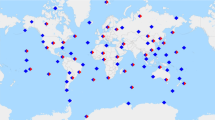Abstract
A global radionuclide monitoring system is being engineered as part of a multi-technology verification system for the Comprehensive Nuclear Test Ban Treaty. The system detects airborne radioactive aerosols and gases that can indicate nuclear weapons test debris. The backbone of the system is a network of 80 remote detection stations that utilize high-volume air sampling and high-resolution gamma spectrometry to provide in-situ assay and near-real time reporting. These stations are linked to the International Data Centre, which is a central data processing hub where raw spectral data is automatically processed, analyzed, and disseminated to the states parties. Measurements are categorized based on spectral content to determine which contain anomalous anthropogenic radionuclides that require intensive radiochemical analysis at a certified laboratory. The resulting system has the capability to measure microbecquerel concentrations of radionuclides and provide accessible data products within minutes of field measurements. During the past year of international operations, the minimum detectable concentrations and spectroscopy processing statistics were recorded as a function of geographical location and time. The results show that this system is an effective tool for nuclear test monitoring, as well as other applications such as radiological emergency response, public health monitoring, and scientific research.
Similar content being viewed by others
References
Comprehensive Nuclear Test Ban Treaty Protocol, United Nations General Assembly, 24 September 1996.
Radionuclide Verification, Conference on Disarmament Working Paper No. 224, CD/NTB/WP.224, March 1995.
L. R. Mason, J. D. Bohner, D. L. Williams, Radionuclide Monitoring Operations Report — Fourth Quarter CY1996, Pacific-Sierra Research Corporation, PSR Technical Report No. 2698, November 1996.
L. R. Mason, J. D. Bohner, D. L. Williams, Airborne Anthropogenic Radioactivity Measurements from an International Radionuclide Monitoring System, Methods and Applications of Radioanalytical Chemistry IV, Conference Transactions, April 1997.
W. C. Evans, Model for the Assessment of Surveillance Strategies (MASS), Pacific-Sierra Research Corporation, PSR Technical Note No. 1076, August 1995.
L. R. Mason, Environmental Radioactivity Monitoring, International Symposium on Nuclear Energy and the Environment Transactions (NEE 96), Beijing, China, October 1996.
Author information
Authors and Affiliations
Rights and permissions
About this article
Cite this article
Mason, L.R., Bohner, J.D. & Williams, D.L. Global radionuclide monitoring in near-real time for verification of the Comprehensive Nuclear Test Ban Treaty. J Radioanal Nucl Chem 235, 65–69 (1998). https://doi.org/10.1007/BF02385939
Received:
Issue Date:
DOI: https://doi.org/10.1007/BF02385939



